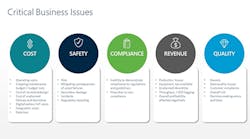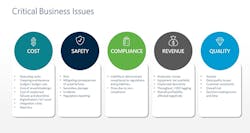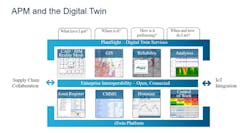Sandra DiMatteo is the Global Director of Marketing for Digital Twin Solutions, Asset and Network Performance at Bentley Systems. She has more than 20 years of experience in digitalization solutions and asset performance management and reliability software. Loukas Koutsoyiannis heads the Asset Performance Management business for Oil and Gas globally at Siemens Energy, and is responsible for driving the product innovation strategy. During the live Q&A portion of the webinar, "How Operations and Maintenance Teams Are Using APM and Digital Twins to Drive Reliability," DiMatteo and Koutsoyiannis discuss how different digital models can help teams better support operations and maintenance.
PS: What's the adoption rate like in industry with digital twins?
SD: It obviously is growing very fast. If you look at all of the research out there, like McKinsey, they're saying that it's going to generate $11 trillion a year in economic value by 2025.
Other like Grand View Research are saying it's going to grow by 38% per year. A lot of people still maybe see it as a vision, but we are helping our customers essentially to think big about it, but then prove small and scale fast. So, it's growing fast.
PS: One of the big challenges in dealing with data is the need for normalization or preparation of the data so that it can be consumed by other tools. How is the industry dealing with this issue, in your experience?
SD: Dirty data is definitely a huge issue. Especially as we look to build the digital twin, the first thing you're doing is looking at how clean is your data. We help our users with tools to make sure that the data is cleansed, so we can leverage all of the existing information that they have.
LK: There is always a challenge, especially when you're looking in the brownfield of how prepared you are in terms of implementing asset performance programs or any program that's looking for the improvement of reliability and looking at data quality. This is always a challenge.
The most effective approach is to have a roadmap, and having a roadmap that actually considers the results that you can generate using the certain data that you have available to you. What I mean by this is, you cannot go from 0 to 100 from one year to another. It's an illusion. So in the Brownfield, I would say it's all about thinking, “Where does the most value sit, where can you generate the most value and then prioritize these activities, be it for data preparation, be it data quality?” The 80/20 rule always applies.
More importantly, when it comes to new projects in the engineering phase, it is a fantastic opportunity to think about data and the way we create data and the way we capture data back into that space, because, ultimately, that will give us the possibility to create the right structure and actually prioritize, even from instrumentation, be it specifying, what type of sensors do we need and what kind of equipment do we need. It will help you in that stage to define what is the right approach when you're thinking about the total cost of ownership, because you will always have the end goal in mind. The key is to never lose sight of your end goal, which is your business value.
Where does the value sit? You should never lose sight of that, because that's what we're heading towards. Many times, I see in my own organization where we are wanting to engineer these projects but really lose sight of the value. That's the most important thing, always keep value inside and prioritize items that can clearly deliver business value.
PS: What do you advise the teams if they hit that roadblock? Part of what I hear you saying is to expect the roadblock and plan for it and work through it. Have you had experiences where you've seen teams encounter that very problem of noisy data?
SD: As we use more and more machine learning, that definitely always has to be the first step, that you look at cleaning that data. We have our data scientists working together with our subject matter experts, and we more and more are helping our users in that process.
LK: I was going to add that equally just in line with the idea of adding value, we had very similar experiences when coming to the reporting of failure data, how to extract the right conclusions. Comparative data, as you could say, a retrospective analysis.
But we took a road map approach. We thought about, where does most of the value lie, where are the major issues we're facing, and you just prioritize these. We said, "Look, these are the areas where we see most of the pain," and we tried to get the low hanging fruit, create value and show that the organization can also believe in what we are doing.
Even small things coming to make a classification, introducing specific governance in terms of point of installation codes for specific failure data, you can come a very long way without actually doing really, really intelligent stuff. You can do some very basic things once you always keep in mind what you're trying to achieve. I would say it doesn't always need to be very complex. Very, very simple measures can yield very good results.
PS: Which department would you rope in to ensure the success of this kind of transition?
LK: There are certainly pillars in the successful implementation of such programs. You always need your champions, the mavericks, so to speak. You are always going to need a true maverick, somebody that's willing to take the risk on a working level. But more even equally importantly, your management needs to be bought into it. Your management needs to be willing to sweep the sheds, as I would say.
It needs to be part of the program, lead by example. I would say just an easy example for this, implementing new inspection plans because of a trust and reliability program. Well, get the managing director to walk with the team on the first few weeks and walk around the site and report the KPIs on a weekly basis and stand-ups.
There's always a need for the champions, for the people that are proud and want to see the results and are ambitious on the working level, but then, equally, you need the management support that is willing to sweep the sheds and willing to get in the shop floor and show their support to these programs, because this is what will make a lot of people buy into these programs and make them a success.
PS: I don't have any 3D models. Can they be created quickly for an existing plant? How can we do that?
SD: Sure. It happens a lot in existing plants. You may not have anything in there, but, if you want to go the 3D model road, you can easily and quickly create them today with software like photogrammetry. It really makes it simple. You just simply are taking a series of high-resolution photographs that are like 50% overlapped, and then you load them to this cloud service called ContextCapture. That's our software to get a photo-realistic representation digitally.
This gives you great training resources. We use it as the basis for our 3D model for the digital twin that we can use machine learning and image recognition to identify assets, and then we add the underlying asset information to that. If you want to go that route, it can be done quite easily, but also there's a ton of other information like 2D and other information that you can start there, start with what you have as well.


